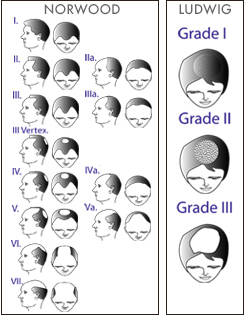Hair Loss Grading Scale Dallas
Hair Loss Grading
 Many classification schemes exist to define types and extent of baldness. However, the most widely accepted standard is the Norwood classification for men and the Ludwig classification for women. With our technique, we can address any extent of baldness from early loss along the frontal hairline (Norwood Type I) to severe global loss (Norwood Type VII). Similarly, for women, we can dramatically restore hair loss from early Ludwig Grade I to advanced Ludwig Grade III hair loss. Our strategy for hair restoration provides the most versatility in achieving the optimal hair density with the most natural result possible for all stages of hair loss for both sexes.
Many classification schemes exist to define types and extent of baldness. However, the most widely accepted standard is the Norwood classification for men and the Ludwig classification for women. With our technique, we can address any extent of baldness from early loss along the frontal hairline (Norwood Type I) to severe global loss (Norwood Type VII). Similarly, for women, we can dramatically restore hair loss from early Ludwig Grade I to advanced Ludwig Grade III hair loss. Our strategy for hair restoration provides the most versatility in achieving the optimal hair density with the most natural result possible for all stages of hair loss for both sexes.
Hair Loss Scales
Norwood Classification for Men
 The Norwood classification for male-pattern baldness is most often used. Type I shows minimal to no hair loss along the fronto-temporal expanse. Type II exhibits fronto-temporal recession that does not extend further than a line drawn through a coronal plane 2 cm anterior to the external auditory canal. Type III hair loss refers to fronto-temporal recession that extends posterior to the coronal plane that lies 2 cm anterior to the external auditory canal. Type III Vertex indicates hair loss that primarily affects the vertex (or crown) region with or without accompanying fronto-temporal recession that does not exceed that described in Type III. Type IV reveals greater fronto-temporal loss than exhibited in Type III along with marked hair loss in the crown area but with a moderately dense swath of hair that bridges the intervening expanse between the two areas. Type V hair loss shows more extensive hair loss in both the fronto-temporal and vertex areas with only a small bridge of dense hair between the two areas. Type VI hair loss reveals a complete absence of any remaining hair that separates the two now confluent areas of alopecia. In addition, the hair loss is more extensive laterally and posteriorly. Type VII represents the most severe expression of male-pattern alopecia with only a narrow-horseshoe configuration that remains along the posterior and lateral border of the hairline.
The Norwood classification for male-pattern baldness is most often used. Type I shows minimal to no hair loss along the fronto-temporal expanse. Type II exhibits fronto-temporal recession that does not extend further than a line drawn through a coronal plane 2 cm anterior to the external auditory canal. Type III hair loss refers to fronto-temporal recession that extends posterior to the coronal plane that lies 2 cm anterior to the external auditory canal. Type III Vertex indicates hair loss that primarily affects the vertex (or crown) region with or without accompanying fronto-temporal recession that does not exceed that described in Type III. Type IV reveals greater fronto-temporal loss than exhibited in Type III along with marked hair loss in the crown area but with a moderately dense swath of hair that bridges the intervening expanse between the two areas. Type V hair loss shows more extensive hair loss in both the fronto-temporal and vertex areas with only a small bridge of dense hair between the two areas. Type VI hair loss reveals a complete absence of any remaining hair that separates the two now confluent areas of alopecia. In addition, the hair loss is more extensive laterally and posteriorly. Type VII represents the most severe expression of male-pattern alopecia with only a narrow-horseshoe configuration that remains along the posterior and lateral border of the hairline.
Norwood also classified a variant of hair loss that afflicts approximately 3% of male patients with alopecia in which the fronto-temporal recession marches progressively posteriorly in a uniform fashion without a central, anterior peninsula of hair. Type IIa refers to a condition in which the entire anterior hairline is receded uniformly across the forehead but does not extend any further posteriorly than 2 cm anterior to the mid-coronal line. Type IIIa reveals alopecia that extends to the mid-coronal line. Type IVa signifies alopecia that has extended past this mid-coronal line. Finally, Type Va indicates significant recession of the hairline into the vertex, and more severe forms of this variant become indistinguishable with Types V and VI.
Ludwig Classification for Women
In addition to the Ludwig scale for female pattern baldness, Olsen in 1999 graded female hair loss into 3 stages based on a frontal accentuation pattern in which the hair loss was more profound in the frontal region that gradually tapered back toward less hair loss in the occiput when viewed with a central hair part. This pattern of hair loss resembles a Christmas tree when viewed with the patient looking down, and according to Olsen accounts for 70% of female pattern loss. In stage 1, there is mild to moderate frontal accentuation loss. In stage 2, there is both frontal accentuation that can be more severe than in stage 1 and mixed with diffuse hair loss. In stage 3, the loss is so severe that only diffuse thinning is principally noted.




